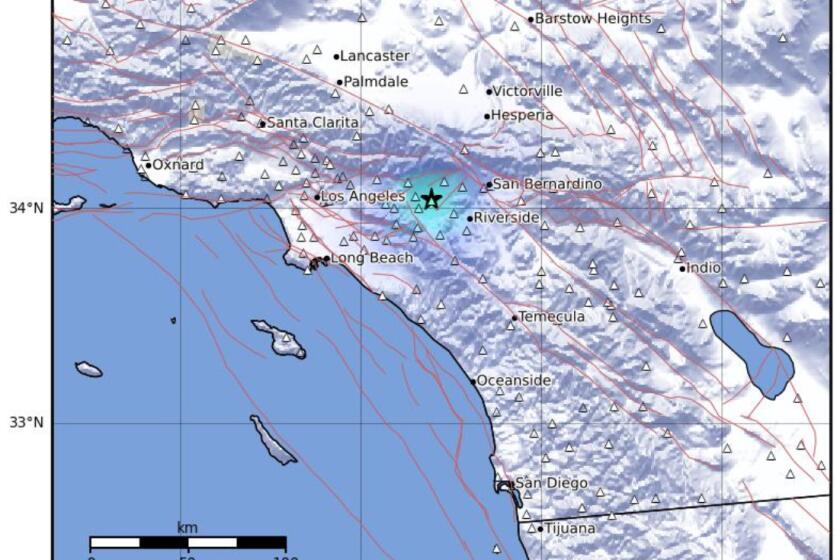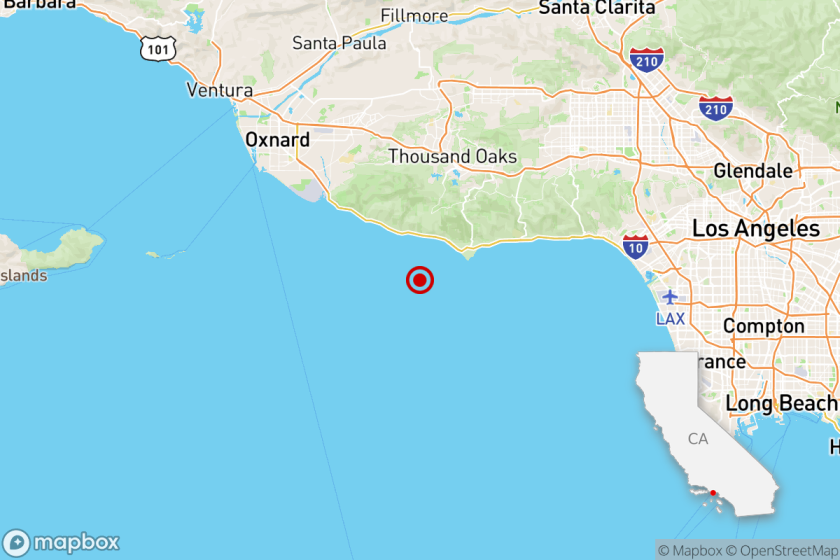Big Easter Sunday quake may have put Southern California at greater risk of future temblors
Equipped with new NASA technology, scientists say there is mounting evidence that the 7.2 Easter Sunday earthquake in Mexicali directed tectonic stress toward Southern California, putting the region at a higher risk for a future quake.
The observations are made possible by a new radar imaging system created by NASA that can detect how land moves after earthquakes. NASA has spent tens of millions of dollars on the Uninhabited Aerial Vehicle Synthetic Aperture Radar, which has been scanning California landforms by aircraft since early 2009.
By comparing old maps with new images after the quake, scientists gained a precise understanding of where the earth moved, and how earthquake tension shifted northward toward L.A. For example, the radar system shows that the April 4 quake and its aftershocks triggered movement on at least six faults, including the Elsinore and San Jacinto faults. Those faults run close to heavily populated areas in eastern Los Angeles County and the Inland Empire.
“There’s a number of activities at the southern parts of these long, dangerous faults that indicate there is a changing stress environment,” said geophysicist Jay Parker, acting chief of the imaging program. “And because these faults are considered hazardous and, potentially may have an earthquake that breaks along their length, this brings the whole picture of activity closer to the Los Angeles area.”
The Elsinore fault might be capable of a magnitude 7 earthquake if its entire length were to rupture in a single event, “which would be bad news for Los Angeles,” said Eric Fielding, a geophysicist at NASA’s Jet Propulsion Laboratory.
Scientists also made another discovery: the identification of a new fault system in California’s Yuha desert north of the Mexican border. Previously, Fielding said, there seemed to be a gap in a network of earthquake faults that ended with the Laguna Salada Fault on the border and the Elsinore fault farther north.
“It explains part of the mystery of how the faults in Mexico relate to the faults in California,” Fielding said. “This connection certainly increases the likelihood of future earthquakes on the Elsinore fault. We just don’t know exactly what the timing is going to be.”
Scientists have said that the pattern of the northward advance of seismic tension may have triggered the 5.4 earthquake on July 7 south of Palm Springs, which was felt as far away as Los Angeles.
None of the observations would have been made possible had it not been for the development of the new radar technology. Scientists hope the technology will be added to a satellite in the future, giving geophysicists and geologists this kind of data worldwide.
The last time such a large quake occurred in Southern California was in the 1990s, and scientists were still using photos on film and transferring observations to paper maps, said Kenneth Hudnut, a geophysicist with the U.S. Geological Survey.
Hudnut said the imagery gave scientists a number of revelations. Among them:
• Proof that earthquakes zipping along a fault can jump over gaps as long as 7 miles. Previously, only jumps of 3 miles had been observed.
• Proof that earthquake faults are punctuated by sections of high and low tectonic stress, a mix that is responsible for the destructive shaking energy that can collapse buildings.
• Proof that earthquakes can reverse directions, an observation that had never been seen before.
Hudnut said the April 4 earthquake showed that at one point, the quake was moving northwest, and then somehow swung backward, in what is called a “back rupture.”
The observation was verified by an eyewitness who likened the movement of the quake to a racecar revving through the desert, trailed by a cloud of dust.
“That’s going to change, in a significant way, the way we do forecast modeling,” Hudnut said.
The mapping effort was led by John Fletcher, a professor at the Center for Scientific Research and Higher Education in Ensenada, Mexico, along with the U.S. and California geological surveys.
The results were presented Thursday in San Francisco at a meeting of the American Geophysical Union.
More to Read
Sign up for Essential California
The most important California stories and recommendations in your inbox every morning.
You may occasionally receive promotional content from the Los Angeles Times.











